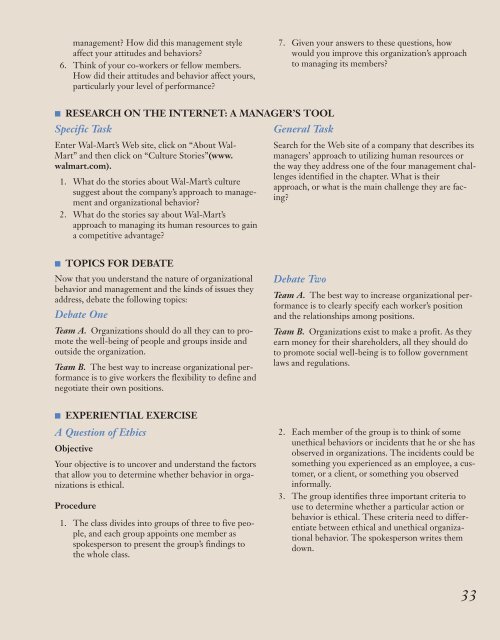chapter - Pearson
chapter - Pearson
chapter - Pearson
You also want an ePaper? Increase the reach of your titles
YUMPU automatically turns print PDFs into web optimized ePapers that Google loves.
management? How did this management style<br />
affect your attitudes and behaviors?<br />
6. Think of your co-workers or fellow members.<br />
How did their attitudes and behavior affect yours,<br />
particularly your level of performance?<br />
7. Given your answers to these questions, how<br />
would you improve this organization’s approach<br />
to managing its members?<br />
■ RESEARCH ON THE INTERNET: A MANAGER’S TOOL<br />
Specific Task<br />
General Task<br />
Enter Wal-Mart’s Web site, click on “About Wal-<br />
Mart” and then click on “Culture Stories”(www.<br />
walmart.com).<br />
1. What do the stories about Wal-Mart’s culture<br />
suggest about the company’s approach to management<br />
and organizational behavior?<br />
2. What do the stories say about Wal-Mart’s<br />
approach to managing its human resources to gain<br />
a competitive advantage?<br />
Search for the Web site of a company that describes its<br />
managers’ approach to utilizing human resources or<br />
the way they address one of the four management challenges<br />
identified in the <strong>chapter</strong>. What is their<br />
approach, or what is the main challenge they are facing?<br />
■ TOPICS FOR DEBATE<br />
Now that you understand the nature of organizational<br />
behavior and management and the kinds of issues they<br />
address, debate the following topics:<br />
Debate One<br />
Team A. Organizations should do all they can to promote<br />
the well-being of people and groups inside and<br />
outside the organization.<br />
Team B. The best way to increase organizational performance<br />
is to give workers the flexibility to define and<br />
negotiate their own positions.<br />
Debate Two<br />
Team A. The best way to increase organizational performance<br />
is to clearly specify each worker’s position<br />
and the relationships among positions.<br />
Team B. Organizations exist to make a profit. As they<br />
earn money for their shareholders, all they should do<br />
to promote social well-being is to follow government<br />
laws and regulations.<br />
■ EXPERIENTIAL EXERCISE<br />
A Question of Ethics<br />
Objective<br />
Your objective is to uncover and understand the factors<br />
that allow you to determine whether behavior in organizations<br />
is ethical.<br />
Procedure<br />
1. The class divides into groups of three to five people,<br />
and each group appoints one member as<br />
spokesperson to present the group’s findings to<br />
the whole class.<br />
2. Each member of the group is to think of some<br />
unethical behaviors or incidents that he or she has<br />
observed in organizations. The incidents could be<br />
something you experienced as an employee, a customer,<br />
or a client, or something you observed<br />
informally.<br />
3. The group identifies three important criteria to<br />
use to determine whether a particular action or<br />
behavior is ethical. These criteria need to differentiate<br />
between ethical and unethical organizational<br />
behavior. The spokesperson writes them<br />
down.<br />
33

















